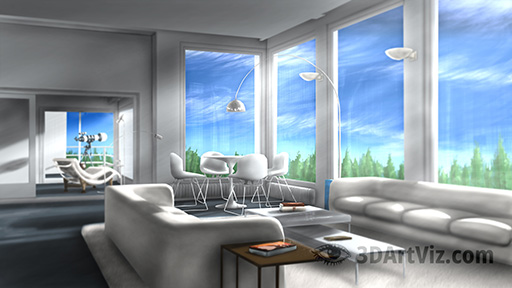How did I deal with…?
Rendering an Interior Environment Using Maya, EXR and Compositing in Nuke
The goal of this project is to render a 2 shots short film showing the interior of a modern style house. Here you can see a post‑produced version of the short film:
The solution I'm developing consists of:
- Modeling the interior, including furniture
- Rigging and animating the cameras
- Lighting and texturing
- Simulating groom and particles, before
- Rendering and compositing.
I'm adding value to this project by showing a cinematic version of the apartment, using expensive furniture and interior decoration. I'm achieving all that by using pre‑production, including research and references gathering. If you want to find out more about pre‑production, click on the following links:
The specific tasks for rendering these 2 shots consist of:
Pre-production
Storyboards and animatics:


And concept art for references on visual development and textures:


I'm rendering the scenes using Mental Ray. That means:
- I'm measuring my set in centimeters
- Exporting color buffers in EXR format, to
- Composite later in Nuke.
Lighting
I'm lighting using a High Dynamic Range Image (HDRI) and adding 2 spotlights to get sharper shadows and more contrast:


Note that I'm filling in dark areas with the smaller spotlight. This is what the lighted meshes look like without textures:


Texturing
I'm using the standard architecture materials from Mental Ray (MIA), and opening UVW only where I'm adding hand painted textures. There are a couple of other texture details worth to notice, like:
- I'm using a displacement map on a cushion made in ZBrush
- Book covers from real books
- Subsurface scattering on the marble piece at the bottom of the big lamp, etc.
This is what the scene looks like before compositing:


Visual Effects
Here you can see the next step in the pipeline, namely visual effects (VFX): Groom on carpet, particles on air, volumetric lights, etc.


Compositing
After rendering all color buffers as EXR, I'm importing them into Nuke for compositing:


If you want to take a closer look at compositing as workflow, click on this case study link:





